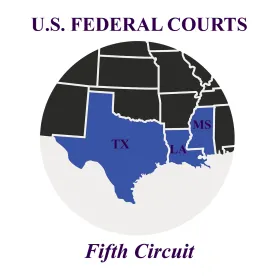The US Court of Appeals for the Fifth Circuit, sitting en banc, recently clarified the right to remove a state court action to federal court under the revised Federal Officer Removal Statute, 28 U.S.C. § 1442(a)(1). In Latiolais v. Huntington Ingalls Inc., the en banc Fifth Circuit concluded that a shipyard, which refurbished Navy vessels in the 1960s and 1970s, was entitled to remove an asbestos action under the Federal Officer Removal Statute, as the claims related to acts performed under the direction of the US Navy.[1] In sum, the Court held that, “[s]ubject to the other requirements of section 1442(a), any civil action that is connected or associated with an act under color of federal office may be removed.”
In Latiolais, the plaintiff-appellee worked as a Navy machinist aboard the USS Tappahannock and was exposed to asbestos while the ship underwent refurbishing for several months. The plaintiff was diagnosed with mesothelioma and died shortly after filing his petition against the shipyard in Louisiana state court. The petition alleges, inter alia, that the shipyard negligently failed to warn plaintiff about asbestos hazards and failed to provide sufficient safety equipment. The petition does not assert any strict liability claims against the shipyard.
The shipyard removed the case to federal court under the Federal Officer Removal Statute, 28 U.S.C. § 1442(a)(1). As amended in 2011, the Federal Officer Removal Statute states, in pertinent part, as follows:
(a) A civil action or criminal prosecution that is commenced in a State court and that is against or directed to any of the following may be removed by them to the district court of the United States…:
(1) The United States or any agency thereof or any officer (or any person acting under that officer) of the United States or of any agency thereof, in any official or individual capacity, for or relating to any act under color of such office….[2]
The Federal Officer Removal Statute allows federal officers to remove cases to federal court, even if the petition raises no federal question. In order to remove a case under the Federal Officer Removal Statute, a defendant must show (1) it is a “person” within the meaning of the statute, (2) it acted “pursuant to a federal officer’s directions,” and (3) it asserts a “colorable federal defense”. See Winters v. Diamond Shamrock Chem. Co., 149 F.3d 387, 396-400 (5th Cir. 1998). Recent Fifth Circuit precedent, such as Bartel v. Alcoa Steamship Co., has also required that the defendant establish “a direct causal nexus” between the plaintiff’s claims and the defendant’s alleged acts under color of federal office.[3] Following that precedent, the original Fifth Circuit panel ruled that the negligence claims asserted against the shipyard (i.e. failure to warn of asbestos hazards) lacked a direct causal nexus to the shipyard’s acts under a federal officer’s direction.
On petition for rehearing, the Fifth Circuit agreed to reconsider en banc the issue of removal, noting that application of the “causal nexus” test has become “extraordinarily confused.” In an effort to “strip away the confusion” and “align with sister circuits”, the en banc Fifth Circuit panel overruled Bartel v. Alcoa Steamship Co. and its progeny to the extent those cases apply the “causal nexus” test to the revised Federal Officer Removal Statute.
In the en banc opinion, the Court explained that the Removal Clarification Act of 2011 amended and expanded the scope of the Federal Officer Removal Statute by inserting “for or relating to” when qualifying the required connection to any act under a federal officer’s direction. The Court clarified that the Removal Clarification Act broadened federal officer removal to actions “not just causally connected, but alternatively connected or associated, with acts under color of federal office.”
The court found that plaintiff’s negligence claims against the shipyard were connected with the installation of asbestos during the refurbishment of the USS Tappahannock, which installation was made pursuant to the direction of the US Navy. The Court further found that the shipyard asserted a “colorable federal defense”. Specifically, the shipyard asserted the federal defense outlined in Boyle v. United Technologies Corp., which protects federal contractors against liability for design defects under certain circumstances. Therefore, the Court held that the shipyard met all conditions for removal under the Federal Officer Removal Statute and remanded to the district court for further proceedings.
By overruling the “causal nexus” text, the en banc opinion in Latiolais v. Huntington Ingalls Inc. broadens the application of federal officer removal to claims simply “connected or associated” with acts performed under the color of federal office. By way of summary, federal officer removal in the Fifth Circuit now requires that a defendant show the following: (1) it has asserted a colorable federal defense; (2) it is a “person” within the meaning of the statute, (3) that has acted pursuant to a federal officer’s directions, and (4) the charged conducted is connected or associated with an act pursuant to a federal officer’s directions.
[1] C.A. 18-30652, 2020 U.S. App. LEXIS 5843, 951 F.3d 286 (5th Cir. 2020).
[2] 28 U.S.C. § 1442(a)(1) (emphasis added).
[3] 805 F.3d 169,172-75 (5th Cir. 2015); see e.g., Savoie v. Huntington Ingalls, Inc., 817 F.3d 457, 462-66 (5th Cir. 2016); Zeringue v. Crane Co., 846 F.3d 785, 793-94 (5th Cir. 2017); Legendre v. Huntington Ingalls, Inc., 885 F.3d 457, 400-403 (5th Cir. 2016).




 />i
/>i

